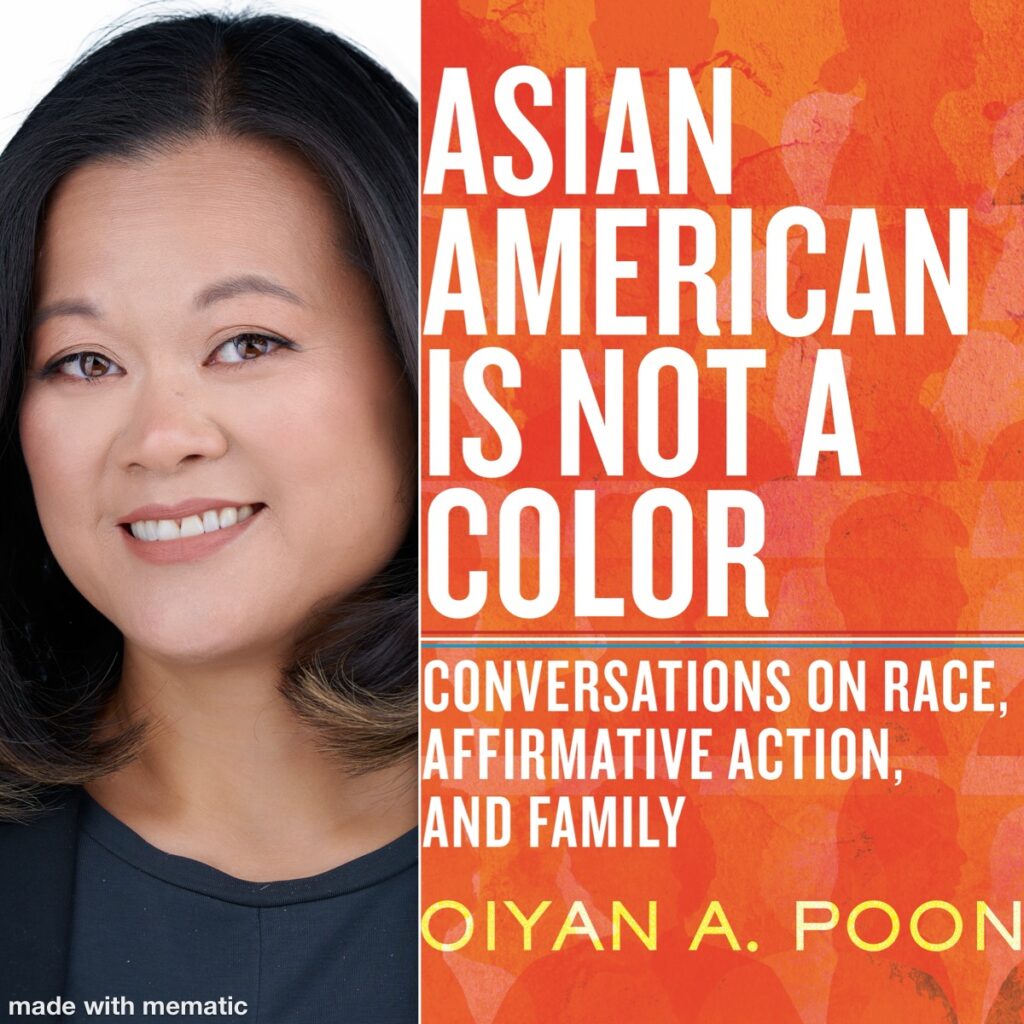Newsletters
Q&A With OiYan Poon
New Information about Upcoming Book Related News
Q&A With OiYan Poon
I am honored to be doing this Q&A with OiYan Poon who is the author of the nonfiction book Asian American Is Not A Color: Conversations On Race, Affirmative Action, And Family. Asian American Is Not A Color was released on April 30th and is available to buy and read wherever books are sold!
Q: OiYan, would you please give a brief description of your book Asian American Is Not A Color: Conversations On Race, Affirmative Action, And Family? Did you always want to be an author? Why or why not?
A: I wrote this book as a love letter to my daughter, Té Té. When she was a toddler, she asked me if we were Black or White. When I told her we were Asian American, she shot back at me, “But mama, Asian American is not a color.” Since then, she has continually asked me questions about race and racism, and about what it means to be Asian American. This book features my insights into how a diversity of Asian Americans make sense of what it means to be Asian American, based on my years of research on how and why Asian Americans feel differently about affirmative action in college admissions. Each chapter opens and closes with a letter to Té Té.
Even though I’ve authored numerous theoretical articles and edited scholarly anthologies, I had never written for general audiences before. Becoming a mom motivated me to do better at engaging with curious audiences with compassion.
Q: How long did it take you to write Asian American Is Not A Color? Why was now the right time to write & publish the book?
A: The research for this book started in 2015. I started writing the book manuscript in 2019 and finished writing it in 2023.
Some of the key questions explored in the book are the nature of mis- and disinformation; why it gains traction, how it travels, and how it shapes political conversations and commitments. Although I centered one policy issue and conversation and one racial identity group—affirmative action and Asian Americans—in the book, these questions are relevant to any hot button topic and are applicable to other communities. Unfortunately, as we have seen in our electoral politics, and more recently in our federal court system, the power of evidence, science, and facts has been diminished (to say the least). I don’t offer any easy answers in the book. Instead, one of my intentions in the book is to invite readers into a civil conversation and to understand the contours of political disagreements, in hopes of improving civic life and discourse.
Q: What lessons & emotions do you hope readers learn and feel after reading Asian American Is Not A Color?
A: I hope readers will feel motivated to learn more about Asian American histories, and to gain a more complex understanding of how racism works in many faceted ways. I also hope that readers will feel a sense of curiosity to learn more about why and how people with political differences from them arrived at their perspectives. Finally, I hope that people walk away feeling a sense of hope and possibilities for them to invest in growing and participating in a racially diverse democracy.
Q: Is the next book you are writing now another nonfiction book similar to Asian American Is Not A Color, a different topic or will you try your hand at fiction this time around?
A: I love reading fiction and wish I was creative enough to write fiction, but I think for me, writing nonfiction for general audiences was already a big leap! So, I plan to keep working at this craft. The next book will likely explore how parents and families in a liberal/progressive and racially diverse city like Chicago navigate school choices. As a Chicago Public School parent now, I’m fascinated and concerned by how racially segregated our schools remain, by how different parents arrive at the choices they make on where to enroll their children, and how these individual choices perpetuate segregation and inequality. It’s essentially an extension of the letters I wrote to Té Té in chapter 5 of Asian American is Not a Color. For this book, Té Té says she wants to write part of it, to share her reflections on her journey toward high school. In Chicago, there are several coveted selective magnet public high schools. Even though there is a beautiful all-IB high school in our neighborhood, people often talk about how important it is to attend one of the magnet high schools. Last year, in third grade Té Té told me out of the blue one day that if she didn’t go to Lane Tech High School, her “life would be over.” Some of our neighbor kids commute over 90-minutes each way to get to their high schools. The mental health pressures and commute burdens placed on children in this choice system don’t make sense to me.
Q: You have appeared on shows and podcasts which are MSNBC’s The Reid Out, National Public Radio’s Code Switch, All Things Considered & Market Place. It sounds like a dream come true! What were your experiences like being on those shows and podcasts?
A: Beyond being nerve-racking at first, it was an honor to be invited into each of these spaces. Each has taught me how to get better at telling the story of my research by developing a stronger understanding of what audiences are interested in. Because all of these occurred prior to the publication of this book, they also made me think that I should consider new ways of sharing what I’ve learned from my research with wider audiences. In some ways each media appearance has been a conversational moment. In that spirit, my book is an offering to continue the conversations happening in the media, with my daughter, and in other spaces.

